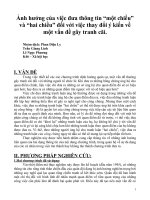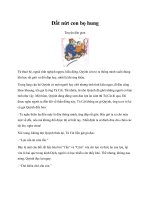Woosh Yx Yaa Datwch Tlingit Math Book ppt
Bạn đang xem bản rút gọn của tài liệu. Xem và tải ngay bản đầy đủ của tài liệu tại đây (4.37 MB, 43 trang )
Woosh Yáx Yaa Datúwch
Tlingit Math Book
Woosh Yáx Yaa Datúwch
Tlingit Math Book
Gaawt'ak.aan Hi Sgoon
Sgóonwaanch Kawshixít
Yakwxwaan Tláach Koo Wlitúw
by the students of Hoonah High School
under the direction of Katherine Mills
Instructor of Tlingit
Acknowledgments
First edition:
Artists: Katherine Mills, Jim Marks, John Marks, Ray Nielson
Proofreading: Nora Florendo [Marks Dauenhauer], Jeff Leer
Typing: Georgina Davis
Darkroom: Herman James
Composition: Dick Dauenhauer
Printing: Andy Hope III
Technical assistance: Alaska Native Language Center, Center for Northern Educational Research, University of Alaska – Fairbanks
First edition: June 1973, 1000 copies
Printed at Sheldon Jackson College, Sitka, Alaska during the third annual Tlingit Workshop
Second edition:
Edited, with new material by Jackie Kookesh, Nora Marks Dauenhauer, and Richard Dauenhauer.
Book design and illustrations by Jackie Kookesh.
Typesetting and production assistance by Michael D. Travis.
A project of the Alaska Federation of Natives, Alaska Rural Systemic Initiative, through contract to Sealaska Heritage Foundation;
funded with grant support from the National Science Foundation.
Copyright © 1973 and 1997 by Tlingit Readers, Inc.
Printed in the United States of America
All rights reserved.
First edition, June 1973.
Second edition, revised, March 1997.
Katherine Mills was born to Paul Brown and Mary Sarabia
on June 5, 1915, at PAF Cannery at the end of Excursion
Inlet, in what is now Glacier Bay National Park, up the bay
from the present day location of Excursion Inlet Packing.
Her Tlingit name was Yakw
xwaan Tláa. She was born into
the Raven moiety, the T'a
kdeintaan clan, and the Kaa Shaayi
Hít (Head House, an extension of Ta
x' Hít, Snail House).
Through her father’s line she was Kaagwaantaan yádi (Child
of Kaagwaantaan) and
Kookhittaan yádi (Child of the Box
House). Her siblings include Irene Lampe of Juneau, Robert
Sarabia of Seward, the late Edward Sarabia of Juneau, and
the late Susan Belarde of Anchorage.
All her life Katherine and her family lived off the land.
From early childhood she gathered nagoon berries, straw-
berries, and soapberries at Dundas Bay, and seagull eggs at
Glacier Bay. She attended what was then the Hoonah Terri-
torial School, and later went to Sheldon Jackson High School
in Sitka.
On April, 11, 1936, Katherine married Gilbert Mills Sr. in
Hoonah. The couple raised a large family. Katherine was a
cannery worker for sixty-two years before retiring. In her spare
time she enjoyed berry picking, fishing, and smoking fish
with her grandchildren.
Katherine was involved in the Tlingit Language movement
from the very beginning. She taught Tlingit language and
culture in the Hoonah public schools for many years. Dur-
ing the course of her teaching, she composed many materi-
als for classroom use. Of these, the best known is her Tlingit
Math Book, published in 1973 by Tlingit Readers, Inc., and
which has remained popular over the years. She participated
in the first Tlingit Language Workshop at Sheldon Jackson
College in 1971, as well as in subsequent workshops. Her
Tlingit Math Book was published during the third such work-
shop. Along with Andrew Hope III, and Nora and Richard
Dauenhauer, and the late Henry Davis, Katherine was a
founder of Tlingit Readers, Inc., and served as a charter mem-
ber of the Board of Directors.
In the 1980s she collaborated with Wally and Marie Olson
on a bilingual pamphlet called “Tlingit Thinking / Lingit
Tundataanee,” published by Southeast Alaska Regional Health
Corporation. In addition, she made many contributions to
the Sealaska Heritage Foundation. She was active in one of
Biography of Katherine Mills
Katherine Brown Mills / Yakwxwaan Tláa
Raven, T'a
kdeintaan
Kaa Shaayi Hít
(Head House, an extension of Ta
x' Hít, Snail House)
Kaagwaantaan yádi (Child of Kaagwaantaan)
Kookhittaan yádi (Child of the Box House)
June 5, 1915 – August 16, 1993
the Foundation’s very first transcription and translation
projects and she also served as a charter member of the El-
ders Advisory Council. Among her still unpublished works
are a short play in Tlingit and English based on the Eagle
Boy legend, and a Tlingit translation of Cannery Kid, a book
written by her grandson Gus.
Katherine was a gifted story teller, and several of her Raven
stories are forthcoming in a volume by Sealaska Heritage
Foundation edited by Nora and Richard Dauenhauer. Her
stories were also among the inspirations for the plays writ-
ten by Nora Marks Dauenhauer and performed internation-
ally by the Naa Kahídi Theater. Her style for Raven stories
was characterized by a classic “dead pan” tone of voice con-
trasting with the outrageous antics of Raven underway in
the stories. Her English versions were characterized by unex-
pected choice of vocabulary. She was one of the funniest
Raven story tellers among the Tlingit tradition bearers.
In contrast to her record of achievement, Katherine was a
very quiet person, so low-key and low-profile as to be easily
overlooked by outsiders. This is a traditional Native virtue,
and causes one to reflect on the proverbs about “not beating
your own drum” and “the empty barrel rattles the most.”
In 1971, Katherine and several other women formed the
Mount Fairweather Dance group and Katherine was named
president. The group went on many tours, and was famous
for its performances of the countless Hoonah “love songs.”
Katherine Mills and Nora Marks Dauenhauer, June 1974, on
Sheldon Jackson College campus, Sitka, for Tlingit Language
Workshop. The Tlingit Math Book was printed during the 1973
Tlingit Language Workshop. Photo by R. Dauenhauer.
Katherine was a lifetime member of Hoonah Alaska Na-
tive Sisterhood Camp No. 12, serving as president for many
years and as a convention delegate. She was also a Tlingit
and Haida convention delegate and served on the Hoonah
city council. She was a lifelong member of the Russian Or-
thodox Church.
In later life, she developed increased difficulty in walk-
ing, and her children got her an electric wheelchair. Despite
her difficulties, she remained active and traveled widely, and
served as an elder and consultant to musuem projects in Se-
attle and Portland. In July 1991, she was one of the South-
east Alaska performers at the Festival of American Folklife
on the National Mall in Washington, D.C. where she sang
from her wheelchair and told traditional stories.
Katherine died on August 16, 1993, and after requiem ser-
vices in Hoonah, she was escorted by a convoy of the largest
seineboats of the Hoonah fishing fleet to the traditional burial
site at the end of Excursion Inlet. Her daughter Phyllis Mills
Bean and her son Gilbert “Butch” Mills Jr. preceded her in
death, but she was survived by daughters Eleanor Moritz,
Judith Brown, and Kathy Marvin, all of Hoonah, and Rose-
mary Jimboy of Lawrence, Kansas; sons Anthony, George,
Thomas, Patrick, Christopher, Stuart, and Jeffrey, all of
Hoonah, and Michael of Juneau. At the time of her death,
she had forty-two grandchildren and twelve great-grandchil-
dren. Her husband, Gilbert, passed away in December 1996.
Pat Mills expressed the family’s grief at their father’s passing,
but took comfort in his faith that, “They’ll be together for
Christmas.”
Katherine Mills, June 1974. Photo by R. Dauenhauer.
Two eagles and three ravens were flying.
How many were there all together?
one 1
Déix ch'áak' ka nás'k yéil át kawdliyeech.
X'oon sáwé tle wóoshteen?
____________ + ____________ = ____________
tléix'
Three brown bears were walking along.
A man shot one.
How many were left?
two 2
Nás'k xóots át woo.aat.
Tléix' yú káach aa oowa.ún.
X'oon sá áa wooneex?
____________ – ____________ = ____________
déix
Five birds are sitting.
Four flew away.
How many are left?
three 3
Keijín ts'ítskw át kéen.
Daax'oon aax kawdliyeech.
Wáa yakugei sá áwu?
____________ – ____________ = ____________
nás'k
A man shot two seals
and two deer.
How many animals did he shoot?
four 4
Déix tsaa aawa.ún
ká déix guwakaan.
X'oon yateeyi át sá aawa.ún?
____________ + ____________ = ____________
daax'oon
A person caught five king salmon.
He kept one.
How many did he sell?
five 5
Keijín t'á kei awdzit'éx.
Tléix' awsineex.
X'oon t'á sá aawahoon?
____________ – ____________ = ____________
keijín
A person has eight spoons in hand.
Ten people need them.
How many spoons are lacking?
six 6
Nas'gadooshú shál áwé du jeewóo.
Jinkaadínáx ku.oo jiyís.
X'oon shál sá oosyéx?
____________ – ____________ = ____________
tleidooshú
Six beaver were trapped.
One sells for twenty dollars.
How much did he get?
seven 7
Tleidooshú s'igeidée awdzigát.
Tleikáa dáanaa tléix' yéi aawahoon.
Wáa yáx sá ayaawadlaak?
____________ ✕ ____________ = ____________
dax.adooshú
People shot thirteen seals.
One shirt takes three seals.
How many shirts did she sew? And how many were left over?
eight 8
Jinkaat ka nás'k tsaa has aawa.ún.
Nás'k tsaa, tléix' k'oodás'x sateex.
X'oon k'oodás' sá aawakáa? Ka x'oon sá áa wooneex?
____________ ÷ ____________ = ____________
nas'gadooshú
Three killerwhales chased two whales.
One got away.
How many did they kill?
nine 9
Nás'k kéetch yaawa.aat déix yáay.
Tléix' sh wudzineex.
X'oon sá has aawaják?
____________ – ____________ = ____________
gooshúk
Thirteen children are sewing beads.
They have one hundred and three bundles of beads.
How many bundles of beads does each one get?
ten 10









